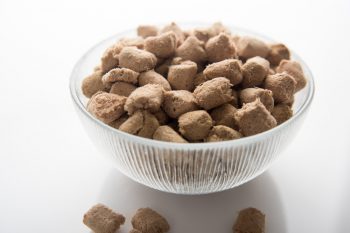The concept of freeze-dried dog food has garnered considerable attention among pet owners due to its convenience and long shelf life. This article explores the necessity and implications of rehydrating freeze-dried food before serving it to dogs.
What is Freeze-Dried Dog Food?
Freeze-dried dog food is created by a lyophilization process where food is frozen and then the ice is removed by sublimation in a vacuum. This process retains the food’s nutritional integrity, texture, and flavor.
The Nutritional Aspect
Freeze-dried food maintains most of the nutrients present in its original form. The process is known for minimal nutrient loss, unlike cooking or canning. However, the absence of moisture changes the food’s texture and density.
To Rehydrate or Not?
Rehydration is not a strict requirement but an option for pet owners. Some dogs prefer the crunchy texture of freeze-dried food, while others may benefit from the softer texture once water is added.
Benefits of Rehydration
Rehydrating dog food restores it closer to its natural state, which can be easier for dogs to eat and digest, especially for those with dental issues or older dogs. It also helps in increasing water intake, which is beneficial for a dog’s hydration status.
How to Rehydrate Freeze-Dried Dog Food
The process involves adding warm water to the freeze-dried food and waiting a few minutes for it to absorb. The amount of water can vary based on the desired consistency and the manufacturer’s instructions.
When Rehydration is Recommended
For dogs with certain health conditions, such as kidney disease or urinary tract issues, increased water intake is crucial. Rehydrating their food can contribute to their overall fluid intake and promote better health.
Considerations and Precautions
Pet owners should consider the increased potential for bacterial growth once the food is rehydrated. It’s important to serve the rehydrated food immediately or store it safely in the refrigerator.
Quality and Types of Water for Rehydration
The quality of water used for rehydration can affect the final product. Using filtered or spring water can avoid potential contaminants found in tap water.
Observing Your Dog’s Preferences and Needs
Each dog has unique preferences and dietary needs. Observing a dog’s reaction to both rehydrated and non-rehydrated freeze-dried food can guide owners in making the best choice for their pets.
Frequently Asked Questions About Freeze Dried Dog Food
1. What is freeze-dried dog food?
Freeze-dried dog food is made by removing the moisture from raw or cooked ingredients through a process called lyophilization. This method preserves the food without the use of preservatives, maintaining most of its original nutritional content, texture, and flavor. It’s a convenient alternative to raw feeding, as it’s less messy and has a longer shelf life.
2. Does freeze-dried dog food need to be rehydrated?
Rehydration of freeze-dried dog food is optional but recommended. Adding water can aid in digestion, make the food more palatable, and ensure proper hydration, especially for dogs that don’t drink enough water. However, some dogs may prefer the crunchy texture of the food when it’s served dry.
3. How long does freeze-dried dog food last?
When stored properly in a cool, dry place, unopened freeze-dried dog food can last for 25 years or more due to the removal of moisture which inhibits bacterial growth. After opening, it should be used within a few weeks to maintain freshness and nutritional integrity.
4. Is freeze-dried dog food nutritionally complete?
High-quality freeze-dried dog food is often formulated to be nutritionally complete for dogs. However, it’s essential to check the label to ensure it meets the nutritional levels established by the AAFCO Dog Food Nutrient Profiles for all life stages.
5. Can I feed my dog only freeze-dried food?
Yes, you can feed your dog only freeze-dried food, provided it’s a balanced and complete diet. Always ensure that the food meets your dog’s nutritional requirements, and consult with a veterinarian if you have concerns about your dog’s specific dietary needs.
6. Is freeze-dried dog food safe from bacteria and parasites?
Freeze-drying effectively reduces the risk of bacteria and parasites because the process involves extreme temperatures that are inhospitable to such microorganisms. However, it’s important to handle the food safely and maintain good hygiene practices to minimize any risk of contamination.
7. How do I store freeze-dried dog food?
Store freeze-dried dog food in a cool, dry place away from direct sunlight. Once opened, keep it in an airtight container to prevent moisture and pests from getting in, which can spoil the food.
8. Are there any dogs that shouldn’t eat freeze-dried food?
Most dogs can eat freeze-dried food, but those with certain health conditions may require a specific diet. Always consult a veterinarian before making significant changes to your dog’s diet, especially if they have health issues.
9. Can freeze-dried dog food help with my dog’s allergies?
Freeze-dried dog food often contains fewer ingredients compared to traditional kibble, which may benefit dogs with food allergies or sensitivities. It’s important to select a formula that doesn’t contain the allergen your dog is sensitive to.
10. How do I transition my dog to freeze-dried food?
Transition your dog slowly to freeze-dried food over the course of several days or weeks. Gradually mix in increasing amounts of the freeze-dried food with their current food to avoid digestive upset. Monitor your dog’s reaction to the new diet and consult with a vet if any issues arise.
The post Does Freeze Dried Food Need to Be Rehydrated? appeared first on iHeartDogs.com.

